On a recent trip to Abu Dhabi, of course a stroll through the streets of Masdar City was something not to miss.
When you’re working in the Clean-tech industry and meeting people in Abu Dhabi, good chance you’ll find them in Masdar City. The city hosts dozens of businesses, several research hubs amongst of course the Masdar Institute of Science and Technology.
Masdar City represents the vision of the future, with its clean energy, efficient use of power, conservation of energy and intelligent architecture.
In this article we have a closer look at the solar energy related sights and the highlights that make Masdar City worth a visit!
How did Masdar city get started?
Since 2006 company Masdar, also referred to as the Abu Dhabi Future Energy Company, has been initiating the construction of Masdar city.
Masdar is a subsidiary of the Investment and Development company Mubadala Development Company (USD 66.3bn of total assests) which is wholly owned by the Abu Dhabi government.
Masdar’s mission: invest in renewable energy and clean technology in Abu Dhabi and around the world for both financial and social returns.
And investing they did..
The entire construction of Masdar City is estimated to cost around USD 19 billion*, with final completion expected in about 10 years from now.
Location – How to get to Masdar City?
Masdar City is just a few minutes drive by taxi from Abu Dhabi airport and is located about 17km east of Abu Dhabi city.
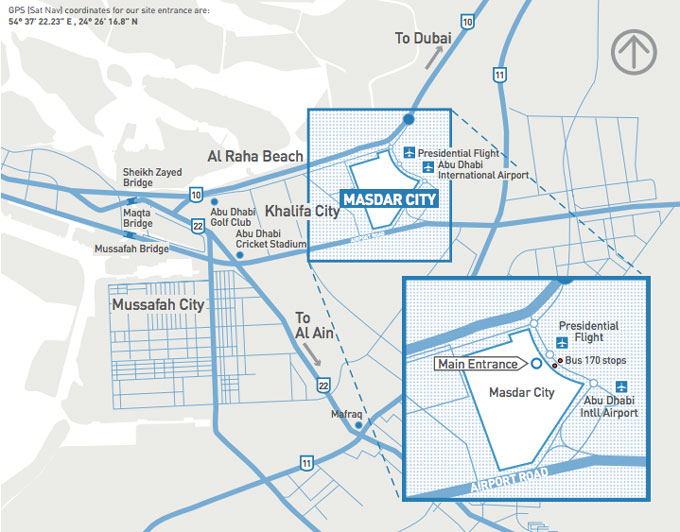
How to get to Masdar City – Map (Source: Masdar)
Masday City is a completely pedestrian and cycle friendly community, where you find a mix of academics and business professionals.
Cycle friendly?
Anyone ever seen an Emirati on a bicycle? 😉
Masdar City is not really a ‘tourist attraction’. It’s a future vision under construction. There aren’t that many signs to direct you, and if you arrive unprepared, you’ll likely miss out on the hidden treasures this city has to offer.
Therefore before visiting the city, make sure to go through the following 7 highlights that you can’t miss:
1. Personal Rapid Transfer (PRT)
The Personal Rapid Transfer (PRT) is a self driving, electric transportation system that brings people on-demand from the parking spaces to the heart of Masdar City.
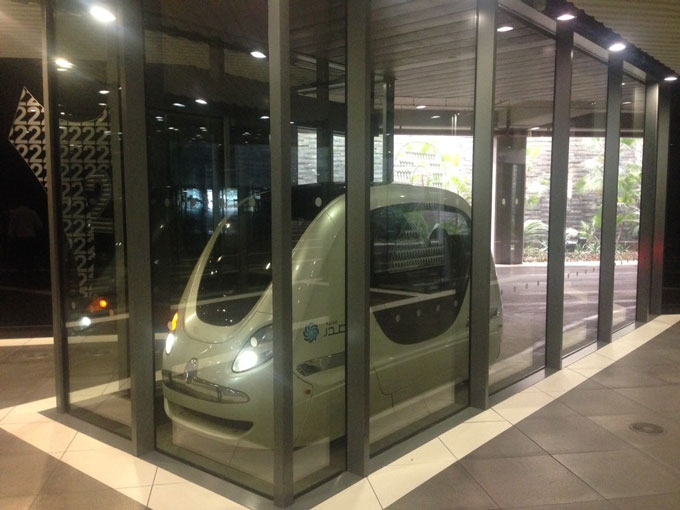
Masdar City – Personal Rapid Transfer – PRT
The electric cars carry lithium battery packs and are charged with the help of Masdar’s solar energy systems. These electric cars have collision avoidance sensors, and use magnets which are embedded in the floor to navigate.
Latest developments in self driving car technology may make the current PRT cars look outdated, but their current purpose of transporting people from the parking lot into the city is well served.
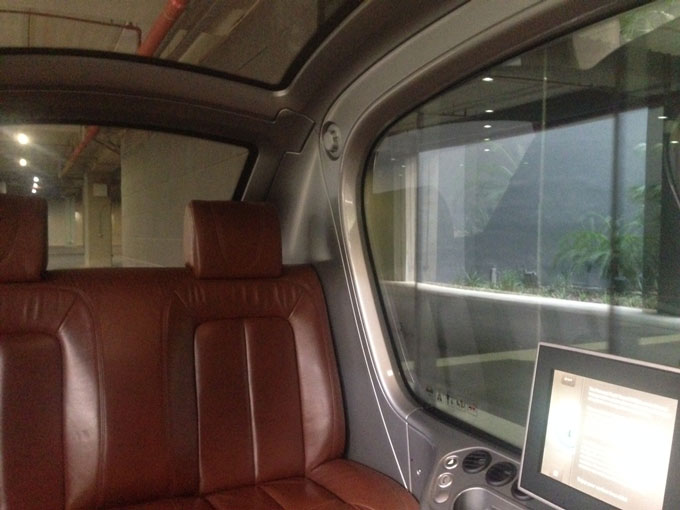
Masdar City – Inside the Personal Rapid Transfer – PRT
The cars were manufacturered by company 2getthere, and designed by Italian design house Zagato, that also works with renown brands such as Ferrari, Aston Martin and Bentley.
2. Masdar Wind Tower
The Masdar Wind Tower is an interesting construction in the middle of the town.
Of course Abu Dhabi has an extemely hot climate. While the winter months are pleasant in the mid °C 20’s, temperatures during the summer months can easily reach °C 40 degrees.
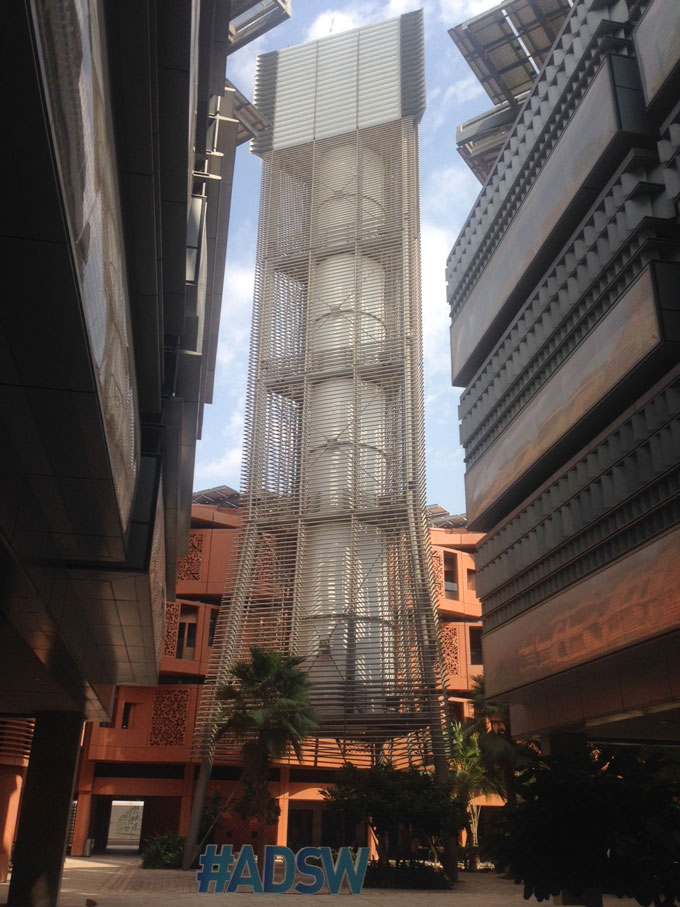
Masdar City – Wind Tower
So how come Masdar City is a pleasant place to walk around in summer?
The main reason for constructing this Wind Tower is to help extend the time that Masdar City is considered ‘Thermally Comfortable’. This way people tend to spend more time outside in the courtyard, making the city a more livable place.
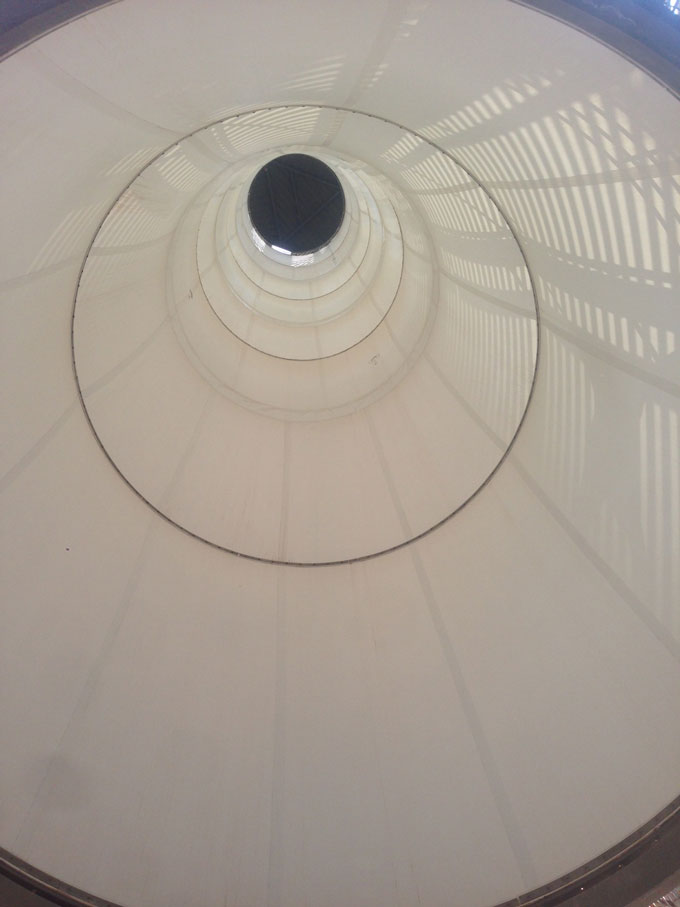
Masdar City – Wind Tower
Instead of naturally ventilating an indoor-space, which is common for standard wind towers, the Masdar Institute wind tower ventilates most of the outdoor courtyard.
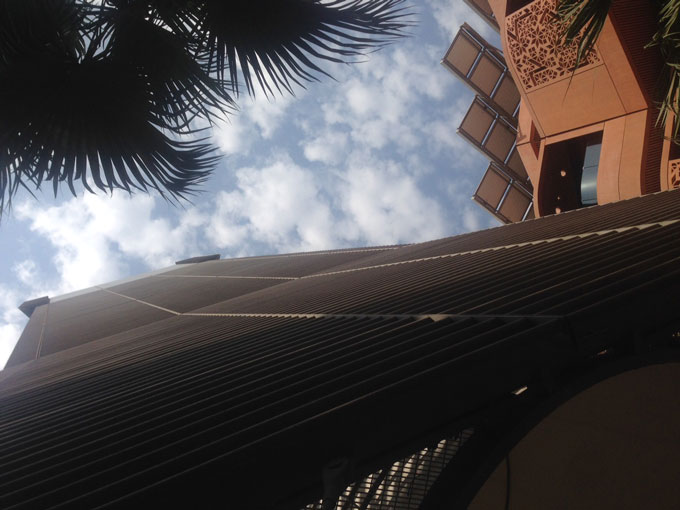
Masdar City – Wind Tower
How does this wind tower work?
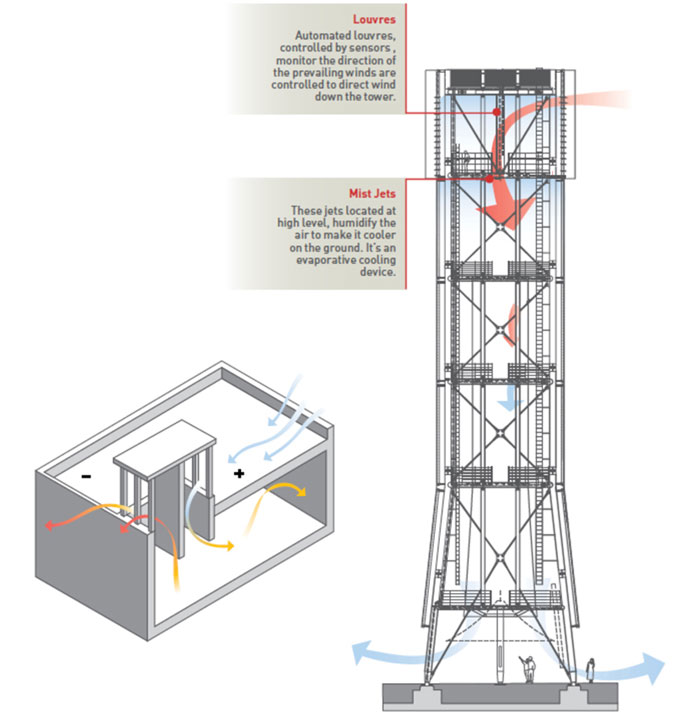
Masdar City – Wind Tower – How it works (Source: Masdar)
The wind tower re-directs moving air from above the city’s rooftops into the courtyard, and when weather conditions are favorable, reduces the temperature of that air through evaporative cooling.
3. Largest solar system in the Middle East
Masdar city is powered by a 10MW solar photovoltaic energy plant.
The plant consists of 87,777 solar modules, constructed on a 22 hectare field. Suntech Power supplied 18,228 solar poly crystalline panels and First Solar supplied 69,552 thin-film modules for this system.
When I visited, it all looked rather dusty… one cannot be wrong with regular O&M (operations and maintenance) work in the sandy parts of the world.
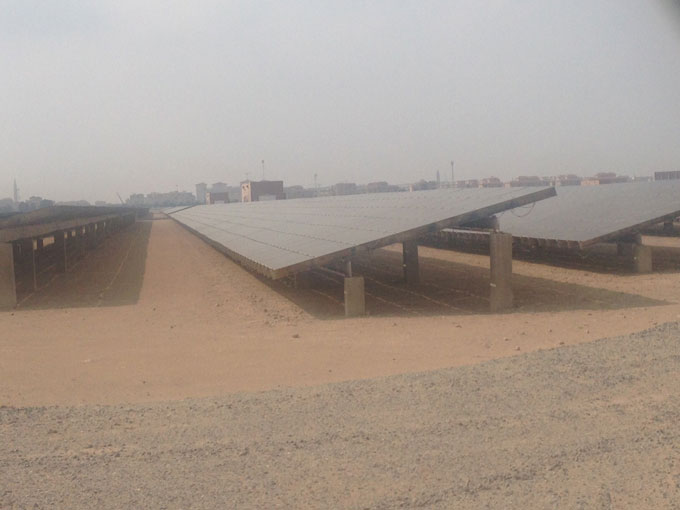
Masdar City – 10MW Solar PV Plant
The PV system produces about 17,500 megawatt-hours of electricity per year and offsets 15,000 tonnes of carbon emissions per year.
At its time of commissioning in 2009, this 10MW PV plant was the largest solar energy system in the entire Middle East.
On top of the ground installations, the PV system on the various roofs have a total capacity of 1MW.
Besides this large 10MW installation, there’s also CPV technology installed:
4. Solar CPV installation Masdar City
The UAE benefits from plenty of sunshine thorough the year, however the desert conditions come with several challenges as well.
During the planning phase of Masdar’s solar systems, Masdar and Spain’s Instituto De Sistemas Fotovoltaicos de Concentración S.A. -(ISFOC) performed an extensive feasibility study to examine the effects of dust, ambient temperature, ground fog and haze on the energy output and reliability of CPV technologies.
On top of that, keeping the equipment clean is another challenge in this arid part of the world, where sweet water for cleaning is mostly acquired through desalination. This turns out expensive..
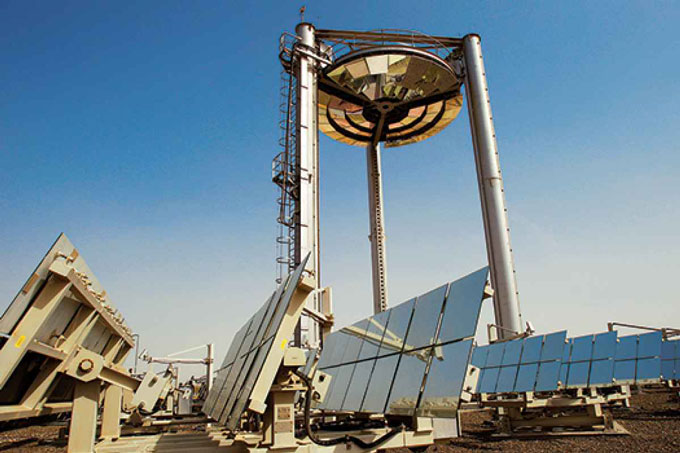
Masdar City – CSP plant (Source: Masdar)
Company Energy Innovation supplied an HCPV installation with their Sunflower technology. HCPV technology is often picked in hot climates over Si and thin film technologies.
What makes HCPV suitable for desert climate?
Main reason is that HCPV is made to withstand high temperature conditions. Sunflower’s HCPV system uses triple junction cells. One advantage over standard Si cells, is that these solar cells have a more favorable temperature coefficient, meaning the performance is less affected by high ambient temperatures.
5. Masdar Solar Hub — UAE’s Solar Testing And R&D Facility
Did you know that the Masdar Institute of Science and Technology houses UAE’s first solar testing and R&D facility?
Perhaps not a tourist attraction, but definitely worth knowing as a professional working in the PV industry!
The Solar Hub is located in Masdar City and with this solar testing and R&D hub, it aims to accelerate the development of solar energy solutions in the UAE and the Middle East.
Their main focus is on:
- Photovoltaics (PV) module testing
- Concentrated photovoltaics (CPV) module testing
- Concentrated solar power (CSP)
- Thermal energy storage (TES)
6.Architecture: ancient building techniques
The initial design of Masdar City was was made by company Foster and Partners. To come up with building solutions that suit the challenging environment of Abu Dhabi, Foster’s design team researched ancient Arab cities such as Muscat and Cairo to see how old building techniques can keep a city cool.
Example of such building techniques are:
1. The use of narrow streets with limited length in ancient cities.
2. The city is built with steep streets that create a deep shadow, with buildings oriented to catch prevailing wind.
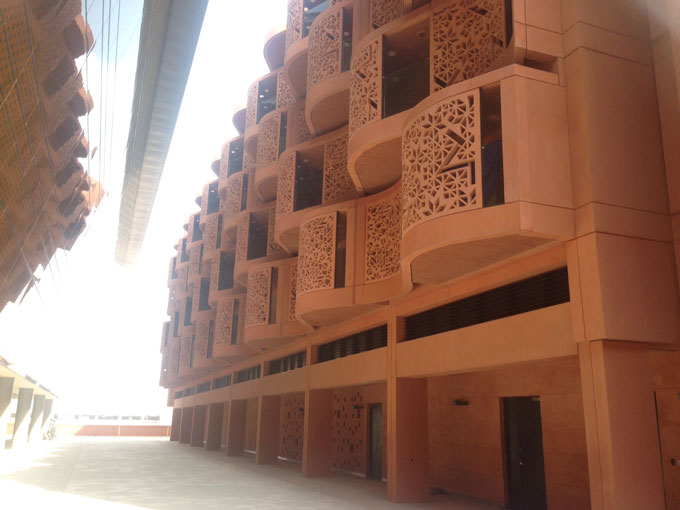
Steep streets that create deep shadow in Masdar City
3. The roofscape is made irregular, to direct breezes into the alleys and create turbulence.
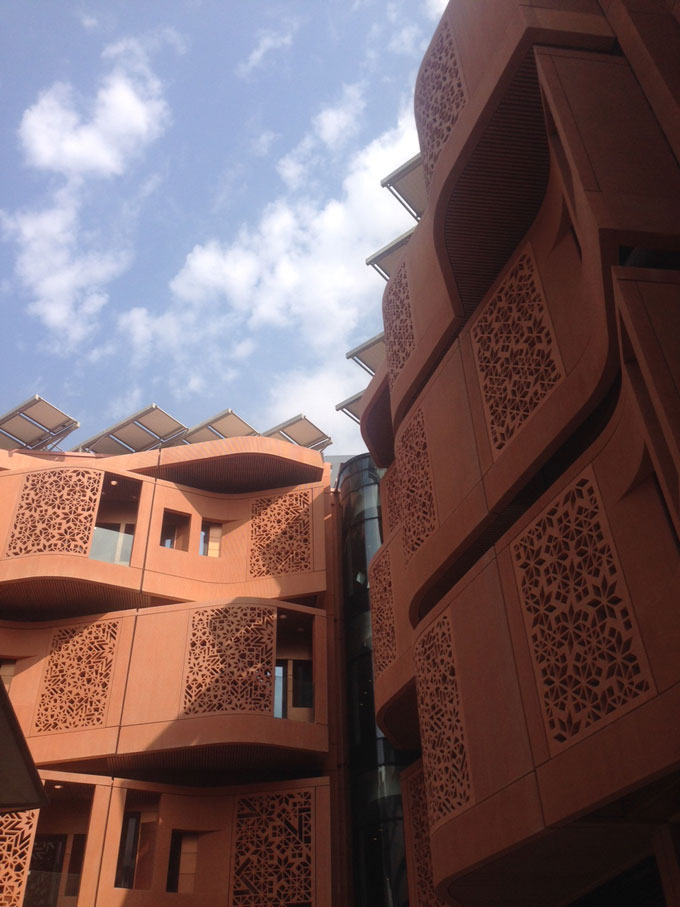
Irregular shape roofscape and outer buildings – to direct breeze into alleys and create turbulence
4. Buildings consist of a heavy mass, so they warm and cool more slowly, evening out the temperature changes from day to night.
7. Cleantech companies and research organizations
When you’re visiting Masdar City, there’s a good chance you’ll come for business. Masdar City is home to a number of cleantech companies, organizations and research institutes, amongst these are:
The International Renewable Energy Agency: an intergovernmental organization to promote adoption and sustainable use of renewable energy.
Masdar Institute of Science and Technology: a graduate level, research-oriented university which is focused on alternative energy, sustainability, and the environment.
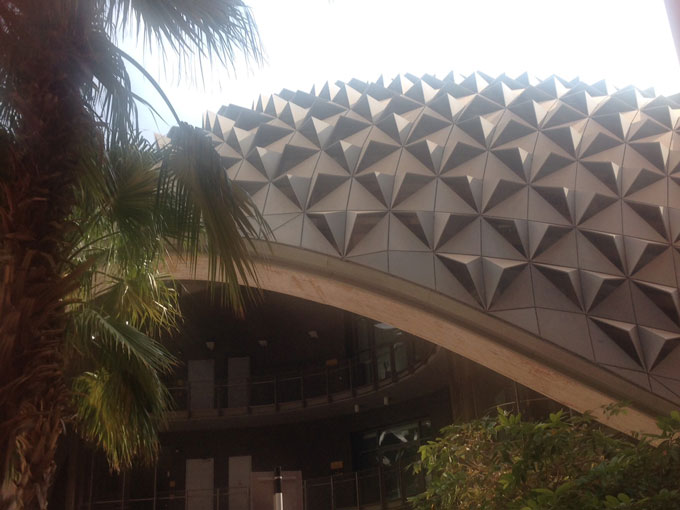
Library building – Masdar Institute of Science and Technology
General Electric – Ecomagination Center: A hub for co-creating sustainability. The ecomagination Center is a hub to discuss the global and regional context for sustainability
Siemens built the first LEED Platinum-certified office building in Abu Dhabi and houses over 800 staff in its Middle East headquarters.
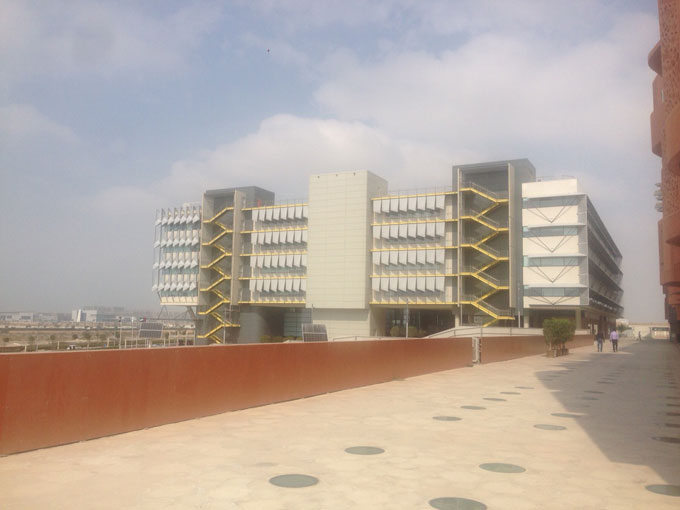
Siemens Middle East headquarters at Masdar City
Schneider hosts a “‘living laboratory’ Innovation Center at Masdar City that will incorporate both a Research and Development Facility and a Technical Centre of Excellence. The R&D facility will focus on long-term sustainable technology research in Green Buildings (Energy efficiency initiatives), Smart Grids (City-wide management system), Water (District Cooling, Treatment Plants) and ICT (Data Centers, Smart Buildings)”.
After going through these highlights you should be well prepared to visit Masdar City. If you want to make the most of it, book a tour guide here.
And also useful, download the official Masdar City Tour Guide.

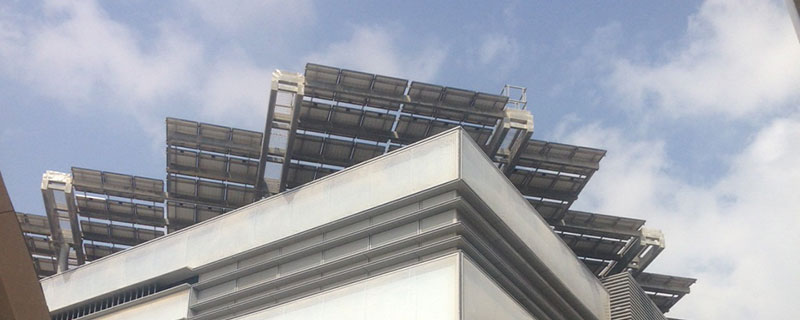

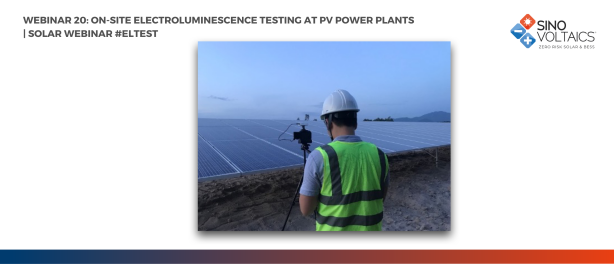



Angélica Amaro
on 12 Aug 2017